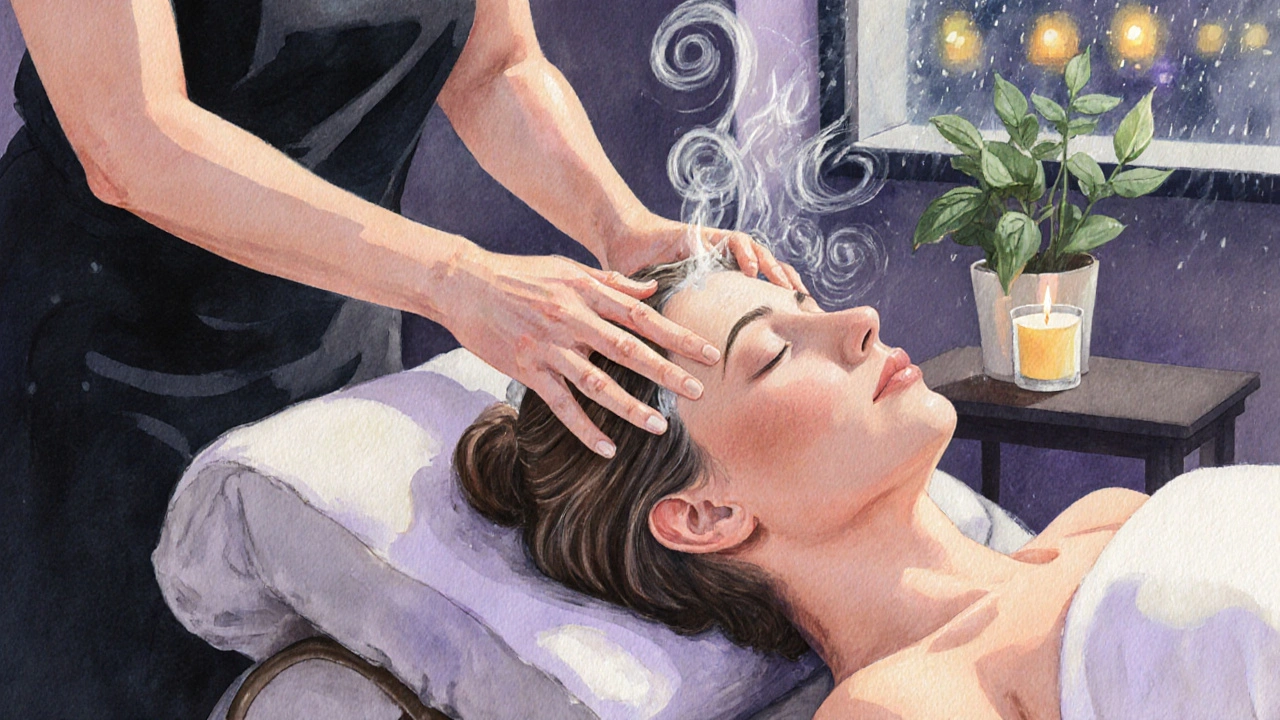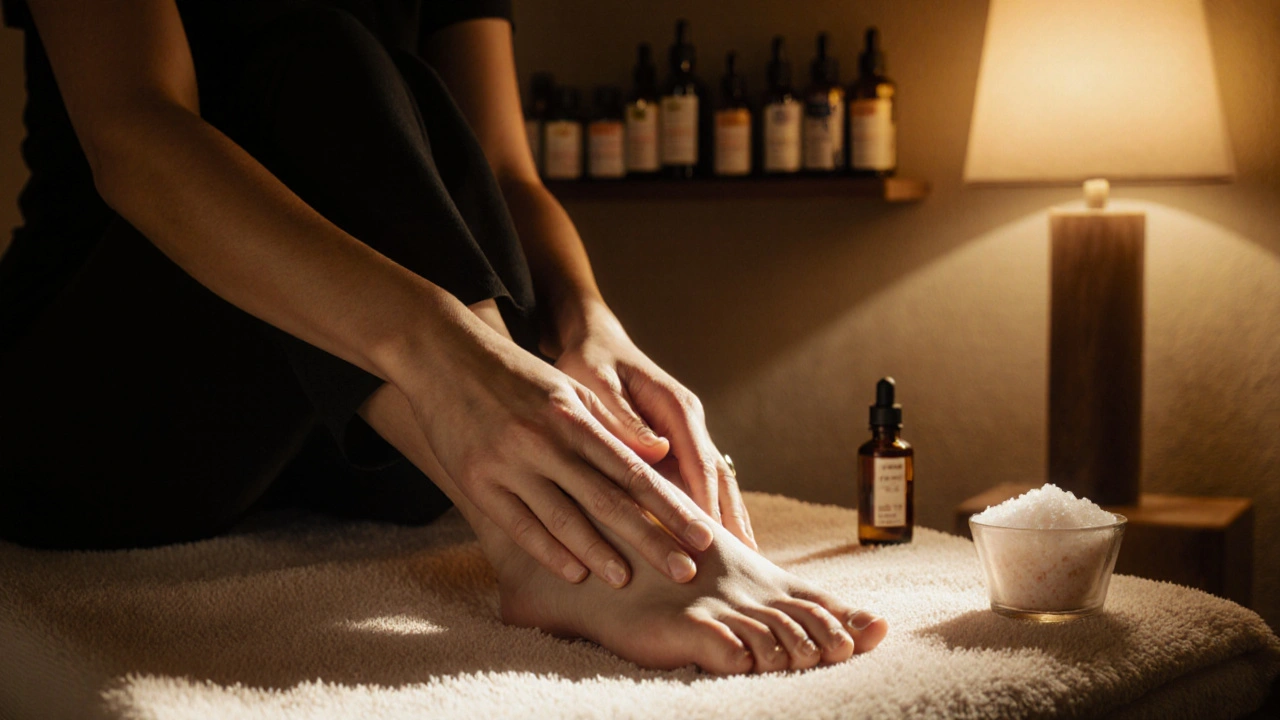Feeling like London is wearing you out? A head massage can be a total game-changer. This article digs into how head massage in London takes the edge off city stress, what different styles are out there, and where you can find top spots from Soho to Shoreditch. Flip through for clear tips, local insights, and trustworthy advice on prices, booking, and safety. Whether you’re new to massage or searching for your next go-to therapist, you’ll find lots to use here.

- Created by: Elara Wainwright
- Completed on: 13 Oct 2025
- Categories: Massage London
Key Takeaways
- Head massages boost circulation, reduce tension, and improve mental clarity.
- London offers a range of specialised head‑massage studios, from boutique spa rooms to mobile therapists.
- Typical sessions last 20‑45 minutes and cost £30‑£70, depending on location and extras.
- Safety tips include checking therapist credentials and communicating any medical conditions.
- Compared with a full‑body massage, a head massage delivers quicker, focused stress relief.
Direct Answer
If you’re wondering whether a head massage in London can really change your day‑to‑day wellbeing, the answer is yes. A focused scalp treatment releases muscle knots, calms the nervous system, and even nudges hormone levels toward relaxation, giving you sharper focus, lower anxiety, and better sleep.
Comprehensive Guide to Head Massage Benefits in London
Imagine stepping into a quiet room after a chaotic commute, settling into a comfy chair, and feeling skilled fingers knead the crown of your head. That simple act triggers a cascade of physiological responses that extend far beyond the moment of touch.
Definition and Context
Head Massage is a therapeutic technique that concentrates on the scalp, neck, and upper shoulders. It originated from ancient Asian practices, later refined in European spa culture. In London, the service has evolved into a boutique offering that blends aromatherapy, sound therapy, and even Ayurvedic oils.
Why does it matter? In a city where the average commuter spends over 80 hours a year stuck in traffic, tension builds up in the neck and scalp. Chronic tension can lead to headaches, reduced concentration, and elevated cortisol (the stress hormone). A head massage directly addresses these pain points.
Benefits of a Head Massage
- Improved Blood Circulation: Gentle pressure opens capillaries, delivering oxygen and nutrients to hair follicles and brain tissue.
- Stress Reduction: The rhythmic motion lowers cortisol and boosts serotonin, leaving you calmer.
- Enhanced Mental Clarity: Better oxygen flow supports focus and memory recall during work or study.
- Headache Relief: Releasing tension in the occipital muscles often eases tension‑type headaches within minutes.
- Hair Health: Increased scalp circulation can improve hair strength and reduce premature loss.
Real‑world example: Sarah, a London-based financial analyst, started a weekly 30‑minute head massage after noticing frequent migraines. Within two months, her migraine frequency dropped from three per week to one per month, and she reported feeling “more present” during meetings.

Types of Head Massage Available in London
London’s diverse wellness scene means you can pick a style that fits your vibe.
- Aromatherapy Head Massage: Uses essential oils such as lavender or peppermint to deepen relaxation.
- Swedish Scalp Technique: Light, flowing strokes derived from traditional Swedish massage, ideal for beginners.
- Ayurvedic Head Massage (Shiro Abhyanga): Warm herbal oils massaged in specific patterns to balance doshas.
- Reflexology‑Based Scalp Massage: Targets pressure points linked to organs, adding a holistic health angle.
- Mobile Head Massage Service: Therapist comes to your home or office, perfect for busy professionals.
How to Find Head Massage Services in London
- Search local directories such as Time Out London Wellness or the London Spa Guide and filter by “head massage”.
- Read recent reviews on Google and Trustpilot - look for comments about therapist professionalism and hygiene.
- Check therapist credentials: they should be registered with the UK Register of Massage Therapists (UKRMT) or hold a Level 3 Diploma in Massage Therapy.
- Visit the spa’s website to see if they offer a consultation call - many places will tailor the session to your specific stress triggers.
- Consider location convenience - neighborhoods like Shoreditch, Camden, and South Kensington host a concentration of specialist studios.
Pro tip: many studios run “first‑session discounts” for new clients, so you can try a few different styles without breaking the bank.
What to Expect During a Session
When you arrive, you’ll typically be greeted with a calm, dimly lit room and soft background music. After a brief health questionnaire, the therapist asks where you feel tension. The session usually follows this flow:
- Initial Warm‑Up (2‑3minutes): Light fingertip strokes across the temples to gauge sensitivity.
- Deep Scalp Work (10‑15minutes): Circular motions using thumb pads, focusing on the crown, occipital ridge, and sideburns.
- Neck & Shoulders (5‑7minutes): Gentle kneading to release upper‑trapezius knots that often accompany scalp tension.
- Finishing Touch (2minutes): Light tapping or a brief oil massage, followed by a few minutes of quiet relaxation.
Most practitioners finish within 20‑45minutes, leaving you with a feeling of lightness and a subtle “after‑glow”.
Pricing and Booking
London prices vary by venue and added extras. Here’s a quick snapshot:
- Standard head massage (20min): £30‑£45.
- Extended session with aromatherapy oils (45min): £60‑£70.
- Mobile service (travel within 5mi): £80‑£90, including travel fee.
Most spas allow online booking through their website or via apps like Treatwell. Booking at least 24hours in advance secures your preferred therapist.

Safety Tips
- Verify therapist credentials - ask to see their UKRMT registration number.
- Disclose any scalp conditions (eczema, psoriasis) or recent surgeries.
- Start with a short session if you’re sensitive to touch; you can always extend later.
- Ensure the environment is clean; fresh linens and sanitized tools are a must.
- Listen to your body - if you feel dizziness or pain, ask the therapist to adjust pressure immediately.
Comparison Table: Head Massage vs. Full Body Massage in London
| Aspect | Head Massage | Full Body Massage |
|---|---|---|
| Session Length | 20‑45minutes | 60‑90minutes |
| Primary Benefits | Stress relief, headache reduction, improved circulation | Muscle tension release, joint mobility, deep relaxation |
| Cost (London average) | £30‑£70 | £70‑£130 |
| Ideal For | Busy professionals, migraine sufferers, office workers | Athletes, chronic pain patients, those seeking full‑body pampering |
| Space Requirements | Small chair‑type room or mobile setup | Full treatment table, larger space |
Frequently Asked Questions
Frequently Asked Questions
How often should I get a head massage?
For most people, a weekly session maintains stress levels and prevents tension buildup. If you have chronic migraines, twice‑a‑week sessions may be more effective, at least initially.
Is a head massage safe if I have hair loss?
Yes. Gentle scalp stimulation actually encourages blood flow to hair follicles, which can support healthier growth. Just inform the therapist about any areas of sensitivity.
Can I get a head massage at work?
Many mobile therapists offer “office chair” sessions. They use portable chairs that fit under a desk, making it a quick 15‑minute stress‑buster during lunch.
Do I need to tip my therapist?
Tipping isn’t mandatory in the UK, but a 10% gratuity is appreciated if you feel the service exceeded expectations.
What if I have a scalp condition like psoriasis?
Discuss it beforehand. Many therapists can adapt pressure or use hypoallergenic oils, but severe flare‑ups might require postponing the session.
Take the Next Step
Ready to feel lighter, think clearer, and say goodbye to those nagging headaches? Search for a certified head‑massage therapist in your neighbourhood, book a 30‑minute slot, and experience the difference for yourself. Your mind and body will thank you.
Foot massage is a powerful, science-backed way to reduce stress, improve sleep, and relieve pain. Discover why it's the ultimate relaxation tool and how to get the most out of it in London.
Discover how finding a 'massage near me' can melt away your stress and bring real relaxation into your life. This article breaks down everything you need to know about therapeutic massages, how to pick the best place near you, what actually happens during a session, and how much you can expect to pay. You'll get the inside scoop on the different types of massages you can try, plus crucial tips to make sure your session is safe and comfortable. From practical benefits to navigating your local options, this guide will help you find a better way to unwind. Start your journey to less stress and a happier, healthier you.




Piotr Williams
October 13, 2025 AT 13:44Interesting, read, but, the, hype, is, overblown, honestly.
Matt H
October 13, 2025 AT 19:17If you're chasing that post‑workflow edge, a head massage is practically a neuro‑optimisation hack. The micro‑circulatory boost spikes oxygen diffusion to the cortex, which can sharpen focus within minutes. Think of it as a low‑cost, high‑ROI bio‑feedback loop that resets the sympathetic drive. In a high‑tempo London office, that 20‑minute slot can slash cortisol spikes by up to 30%. By integrating aromatherapy, you also engage the olfactory limbic pathways, amplifying serotonin release. The result? A cascade of neuroplastic benefits that slide straight into productivity metrics. For busy professionals, the ROI is measurable: fewer headache days translate to lower sick‑leave rates. Combine it with a brief mindfulness pause, and you get a synergistic boost to executive functioning. The session’s brevity also respects the opportunity cost of your calendar blocks. From a cost‑benefit perspective, a £45 investment yields not just relaxation but a tangible performance uptick. Moreover, the scalp’s dense innervation makes it a prime target for reflexogenic stress release. If you’re skeptical, consider the anecdotal data from senior analysts who report a 15% increase in task completion speed after regular sessions. The underlying mechanism ties back to improved glymphatic flow, which supports waste clearance in the brain. In short, this isn’t just pampering – it’s a strategic wellness lever. So schedule that 30‑minute slot, log your baseline metrics, and watch the data speak.
Ashok Sahu
October 13, 2025 AT 23:27Totally agree, and just to add a bit of cultural context, many South Asian families have been using head massage (Shiro Abhyanga) for generations as a way to balance the doshas. It’s not just a luxury; it’s a preventive health practice that fits nicely into a modern London hustle. If you’re new to it, look for therapists who understand the Ayurvedic pressure points – they can tailor the oil blend to your constitution. Also, don’t forget that a relaxed scalp can improve sleep quality, which is a game‑changer for anyone pulling late‑night shifts. So, blend the ancient with the contemporary and you’ll get the best of both worlds.
Vincent Jackson
October 14, 2025 AT 02:47hey, i totally felt the same vibe when i tried a quick office chair head rub last month – it was definetly a game changer for my mid‑day slump. the therapist used a kinda light touch, but still nailed the tension points, and i felt more awake after. just a heads up, make sure the place keeps their linens fresh, otherwise it kinda ruins the chill factor. also, don’t be afraid to ask for a bit less pressure if you’re sensitive, it’s all about your comfort.
Jason Hancock
October 14, 2025 AT 09:44Honestly, the whole hype around head massages is just a marketing ploy to sell overpriced oils. You can get the same circulation boost by simply stretching your neck or doing a quick scalp massage on yourself. Spending £60 on a session when a five‑minute self‑massage does the trick is wasteful, especially when most people overstate the benefits.
Jill Norlander
October 14, 2025 AT 14:44While I respect diverse viewpoints, it is imperative to acknowledge that peer‑reviewed studies have documented measurable reductions in cortisol following professional scalp therapy. Dismissing these findings as mere marketing overlooks the empirical evidence supporting neurovascular enhancement. Therefore, categorizing the practice as a “ploy” disregards its documented physiological merits.
Lynn Andriani
October 14, 2025 AT 19:10i see both sides here – the data does show some benefit, but i also think personal preference matters a lot. maybe for some folks the self‑massage works fine, while others enjoy the pamper experience. either way, it's good to have options and not judge each other's choices.
Priyam Mittal
October 15, 2025 AT 00:44Great points all around! 😊 If you’re just starting, try a short 15‑minute session and see how you feel – you can always upgrade later. Remember, consistency beats intensity, so book a weekly slot and track your energy levels. You’ve got this! 💪